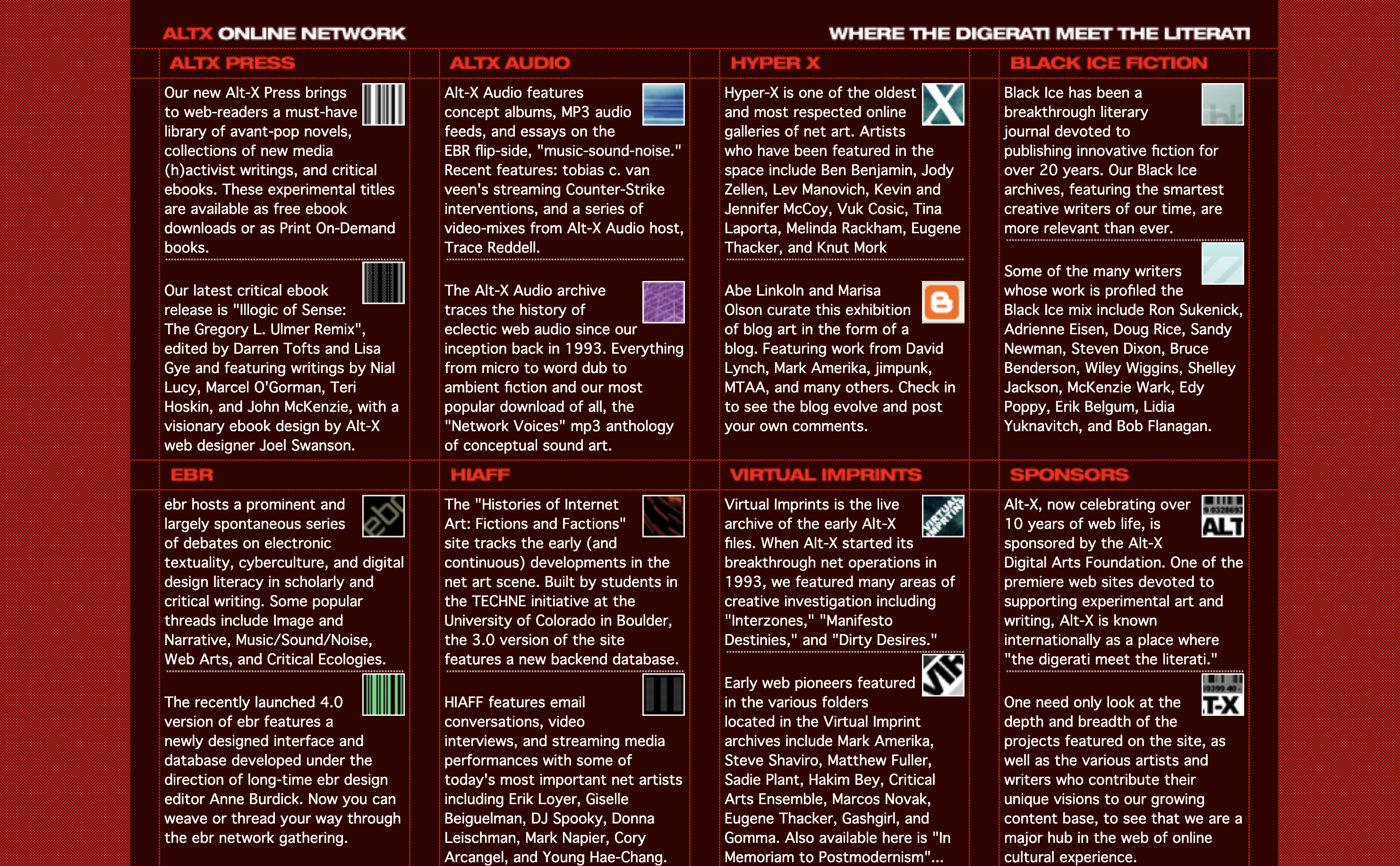The featured essays on this site trace evolving modes of publishing, authorship, scholarship and creativity in digital space. They reflect ebr’s role as both witness and catalyst to transformations in media, interface, and networked thought. Emerging in 1995 alongside the World Wide Web and the increasing accessibility of personal computers, ebr was among the first literary-critical platforms born online. From early interrogations of hypertext to recent meditations on generative AI, algorithmic culture, and posthuman aesthetics, each piece embodies the journal’s commitment to experimentation, critical feedback, and collaborative emergence. More than topics, these are conditions that shape reading, writing, and thinking today.
In its origin, ebr launched via Alt-X—a hybrid zone of experimental literature, net art, and radical theory founded by Mark Amerika. This early phase was shaped by collaborations with Ronald Sukenick and Black Ice magazine, extending a lineage of postmodern and avant-garde literary production into digital space. Alt-X exemplified a DIY ethos, critical play, and a reimagining of authorship attuned to network culture and emergent media forms.

The early ebr volumes (1–12) trace the emergence of electronic literature and digital criticism as formative forces in late-20th-century media culture. With its 2004 transition to a database-driven architecture—marking the shift to ebr 3.0 and later ebr 4.0—the journal introduced modular publishing via threads, glosses, and gatherings. These innovations created a semantic, community-curated environment for collaborative annotation, editorial weaving, and theoretical linking beyond the logic of traditional issues.
Today, ebr is supported by the Center for Digital Narrative at the University of Bergen, reinforcing its transnational editorial structure and commitment to open-access, post-disciplinary inquiry. Essays are chosen for their historical resonance and for the experimental ways they explore media and collaborative authorship—while acknowledging that the contributor base is still largely European and North American and that broader representation remains an active goal. Taken together, the pieces show how writers, artists, and theorists treat computers as collaborative tools for creative intervention across art, culture, academia, society, and politics, demonstrating how critical practice can both respond to and reshape the possibilities of networked life.
essays:
The selected essays below are drawn from over 3,000 published pieces spanning the first twelve volumes on Altx to its current home at electronicbookreview.com.
- "A Review of Books in the Age of Their Technological Obsolescence"
by Joseph Tabbi (1995) - "MY BODY THE LIBRARY / Janet: Body art and World Wide Web site" by Michael Joyce (1995)
- "Notes from the Digital Overground"
by Mark Amerika (1995) - "A Project for a New Consultancy"
by Gregory L. Ulmer and Joseph Tabbi (1996) - "Something Is Happening, Mr. Jones"
by Marjorie Perloff (1996) - "Way of Seeing/Ways of Being"
by Steve Tomasula (1997) - "Machine Visions: Toward a Poetics of Artificial Intelligence"
by Matthew Kirschenbaum (1997) - "Hamlet on the Holodeck"
by Janet Murray (1998) - "An Mosaic for Convergence"
by Charles Bernstein, programming by Dante Piombino (1997) - "Joseph McElroy: Fathoming the Field"
by William S. Wilson (1998) - "Stitching Together Narrative, Sexuality, Self: Shelley Jackson's 'Patchwork Girl'"
by George P. Landow (1999) - "Key Concepts of Holopoetry"
by Eduardo Kac (1999) - "Translation and the Oulipo: The Case of the Persevering Maltese"
by Harry Mathews (1999) - "To Be Both in Touch and in Control"
by Stephanie Strickland (1999) - "Constrained Thinking: From Network to Membrane"
by Paul Harris (2000) - "Cybertext Killed the Hypertext Star"
by Nick Montfort (2002) - "active/onBlur: An Interview with Talan Memmott"
by Mark Amerika (2002) - "A Poetics of the Link"
by Jeff Parker (2002) - "The Code is not the Text (Unless It Is the Text)"
by John Cayley (2002) - "The Pleasure (and Pain) of Link Poetics"
by Scott Rettberg (2003) - "Game Design as Narrative Architecture"
by Henry Jenkins (2004) - "Prospects for a Materialist Informatics: An Interview with Donna Haraway"
by Donna Haraway and Lisa Nakamura (2006) - "A Map of Relations: Three Interfaces in the Electronic Book Review"
by Ewan Branda (2007) - "Water on Us"
by Joseph McElroy (2010) - "Electronic Literature: Where Is It?"
by Dene Grigar (2012) - "Post-Digital Writing"
by Florian Cramer (2012) - "Pasts and Futures of Netprov"
by Rob Wittig (2015) - "Towards Minor Literary Forms: Digital Literature and the Art of Failure"
by Illya Szilak (2015) -
"Literary Texts as Cognitive Assemblages: The Case of Electronic Literature"
by N. Katherine Hayles (2018) - "Mapping Electronic Literature in the Arabic Context"
by Reham Hosny (2018) - "Electronic Literature Translation: Translation as Process, Experience and Mediation"
by Søren Bro Pold, María Mencía, and Manuel Portela (2018) - "Getting Lost in Narrative Virtuality" by Will Luers (2018)
- "Third Generation Electronic Literature"
by Leonardo Flores (2019) - "E-Lit’s #1 Hit: Is Instagram Poetry E-literature?"
by Kathi Inman Berens (2019) - "These Waves …: Writing New Bodies for Applied E-literature Studies"
by K. Alysse Bailey, Lauren Munro, Hannah Fowlie, Megan Perram, Christine Wilks,Sarah Riley,Carla Rice, Astrid Ensslin (2020) - "Better with the Sound On; or, The Singularity of Reading and Writing Under Constraint"
by Hannah Ackermans (2021) - "River: Forking Paths, Monsters, Simultaneous Timelines and Continuity over 25 Years of Creative Practice" by Caitlin Fisher (2021)
- "In Defense of the Difficult"
by Eugenio Tisselli and Eugenio Rui Torres (2021) - "Thoughts on the Textpocalypse"
by Davin Heckman (2023) - "Embodied AI: An Extended Data Definition" by David (Jhave) Johnston (2023)
- "ebr historical intertext" by Lai-Tze Fan (2023)
- "ebr: meeting point for conversations" by Anna Nacher (2024)